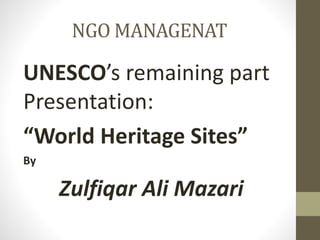Building peace in the minds of men and
- 1. NGO MANAGENAT UNESCOŌĆÖs remaining part Presentation: ŌĆ£World Heritage SitesŌĆØ By Zulfiqar Ali Mazari
- 2. ŌĆ£Building peace in the minds of men and womenŌĆØ
- 4. ŌĆó The UNESCO World Heritage Sites are places of outstanding cultural or natural importance to the common heritage of humanity. ŌĆó The programme was founded with the Convention Concerning the Protection of World Cultural and Natural Heritage which was adopted by the General Conference of UNESCO on 16 November 1972 in Paris
- 5. World Heritage Sites In 2012, 189 out of 194 world nations work with UNESCO to protect these sites.
- 7. World Heritage Sites ŌĆóThere are total 981 World heritage sites ŌĆóLocated in 160 states party ŌĆóOf those 759 are Cultural ŌĆó193 Natural ŌĆó29 Mixed ŌĆó44 properties in Danger because of WARs, Natural Disasters, Environmental conditions, Pollution, Poaching, Urban sprawl, Tourism, Vandalism and looting.
- 9. World Heritage Sites Lists further meet at least 10 selection criteria
- 12. World Heritage Sites in Pakistan ŌĆó Pakistan approved the convention on 23 July 1976, making its historical sites eligible for inclusion on the list. ŌĆó UNESCO has nominated six sites in Pakistan as World Heritage Sites. In 1980, The first sites to be inducted in the list were ŌĆó 1)Mohenjodro 2) Takht-i-bahi & Sehr-i-Bahlol and 3) Taxila
- 13. World Heritage Sites in Pakistan In 1981, two other sites were inscribed. ŌĆó4) Shahi Fort & Shalamar Garden ŌĆó5) Historical Monuments at Makli ŌĆó6) Rohtas Fort.
- 14. Mohenjodro (Archeological Ruins) Period 26th century BC to 19th century BC The 5000-year-old city was one of the largest and earliest urbanized settlements in South Asia. Ruins, first discovered in 1922 and Major excavations carried out in 1930's. After 1965 excavations were banned.
- 15. Taxila ŌĆó Period 5th century BC to 2nd century AD ŌĆó Taxila is an archaeological site located in the Rawalpindi District, 30 km northwest of Islamabad. The city dates back to the Gandhara period and contains the ruins of the Gandh─üran city of Takß╣Ża┼øil─ü which was an important Hindu and Buddhist centre, and is still considered a place of religious and historical sanctity in those traditions.
- 16. Takht-i-Bahi (Buddhist Ruins) and Sahr-i-Bahlol ŌĆó Period 1st century ŌĆó Takht-i-Bahi, meaning spring throne, is a Buddhist monastic complex dating to the 1st century BC located on top of a 152 m high hill. The ruins are located about 16 km from Mardan and 80 km from Peshawar. Sahr-i- Bahlol is a small fortified city, dating from the same era, located near Takht-i-Bahi. The historical complex is a complete Buddhist monastery consisting of four main groups; the Court of Stupas, a monastic complex, a temple complex, and a tantric monastic complex.
- 17. Shahi Fort and Shalamar Garden ŌĆó Period ----- 1556 ŌĆó The Fort and Shalamar GardenŌĆ”.are two royal developments from the Mughal era. ŌĆó It has been destroyed and rebuilt several times during its history. ŌĆó The Shalamar Garden constructed by the emperor Shah Jahan in 1642. ŌĆó The gardens are influenced by Persian and Islamic traditions and cover 16 hectares of land area.
- 18. Historical Monuments at Makli, Thatta ŌĆó Period---- 14th century to 18th century ŌĆó Makli is a necropolis in the archaeological city of Thatta dating back to 14th century. ŌĆó Monuments and tombs in Makli are built from high quality stone, brick, and glazed tiles representing the civilization of Sindh of the time. ŌĆó Tombs of famous saints and rulers are still preserved.
- 19. Rohtas Fort ŌĆó Period --------- 1541 ŌĆó Rohtas Fort is a garrison fort built by Sher Shah Suri, located about 16 km from Jhelum in Punjab, Pakistan. The fort is an exceptional example of Islamic military architecture, integrating artistic traditions from Turkey and the Indian subcontinent. ŌĆó Location---- Kahan River to control the Ghakkars. Name derived---- Rohtasgarh, the site of Sher Shah's victory in 1539 over a Hindu ruler.


















